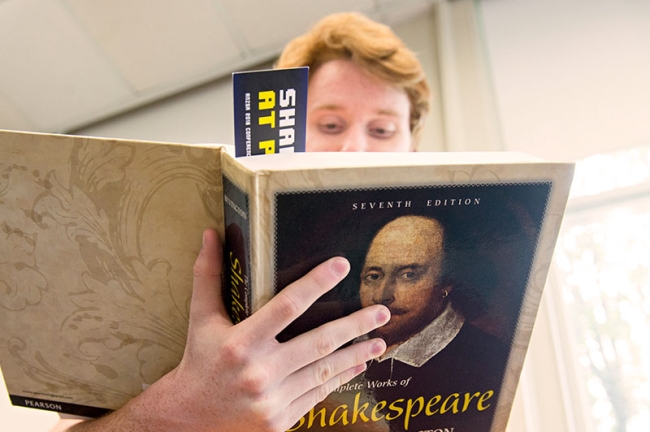You have /5 articles left.
Sign up for a free account or log in.

University of Lynchburg
Imagine the scene: energetic and engaged faculty members volunteer to staff tables and speak to prospective students at an open house on campus. They are ready with banners, brochures and swag to greet potential future students. A few tables are flooded with interest—mostly the health sciences and business—while some of the most traditional majors see almost no traffic.
This is a familiar story at many colleges across the U.S. When institutions are able to grow their enrollment, the growth seems to be concentrated in a few “likely suspect” majors. When enrollment shrinks, it has been shrinking disproportionately in the humanities and social sciences. These programs have historically formed the very backbone of the modern liberal arts college. The waning interest of students in these classic disciplines has been cracking institutions at their fault lines, unbalancing faculty hiring and turning gen ed core discussions into turf battles. “If we are not careful, the humanities and social sciences will disappear,” says Sabita Manian, associate dean of social sciences at the University of Lynchburg
Higher Education Personalities
There are many theories about why these fields are no longer experiencing demand, the most common of which focuses on the unwillingness of parents to invest in a degree that doesn’t obviously lead to a career outcome. As an enrollment manager for over 20 years, that seems logical, but as a dad of two students in this age group, I’m not completely buying it. I see my fellow parents very willing to support their kids in whatever path they are passionate about, no matter how impractical it may seem. I think it is more likely that it is the students who are not convinced. Colleges are not even getting them to the point where they are willing to ask their parents about it. My belief is that we don’t really know our audience, or how our audience has changed, and what students currently perceive as their choices.
One useful framework to understand this changed landscape is temperament theory, developed by David Keirsey. It is an easy-to-use personality theory that I find very helpful in considering large-scale social trends. Temperament theory divides the population into four basic categories, based on two questions: Are they abstract or concrete thinkers, and do they use tools (which could be anything from technology to languages, art or athletic talent) in a cooperative or utilitarian way? While this is not a foolproof predictor, students from each of the four temperament types gravitate to certain career choices.
In past generations, college was the world of abstract thinkers. The college classroom belonged to students who lived in the world of ideas, and abstract thinking was the coin of the realm for gaining access to leadership jobs. On the one hand, abstract thinkers who were utilitarian in their approach (willing to stretch and break rules and using physical objects in ways that value effectiveness over others’ feelings) filled the hard sciences and engineering. These are Keirsey’s Rationals.
On the other side of the abstract spectrum are the Idealists, who also love ideas but use tools cooperatively within agreed-upon boundaries so as to consider people. They filled the seats of classrooms in the social sciences and the humanities. Those fields were also the gate of entry for the high-status fields of law, the ministry and politics.
The Rise of Concrete Thinkers
Here’s the challenge. Keirsey estimates that only 25 percent of the U.S. population fits into these two abstract temperaments—15 percent Idealists and 10 percent Rationals. The vast majority of the population is concrete in its thinking, preferring the world of everyday language and objects to the world of ideas. In former times, this meant that concrete thinkers who wanted access to high-status positions, especially in the professions, had to learn to think more abstractly and find a path through the social sciences. In some ways, the story of the democratization of higher education in the late 20th century is the story of opening colleges to concrete thinkers. After World War II, the demand for upward mobility was insatiable, and the limited pathways through the abstract-thinking fields were not enough to contain it.
How did we solve this challenge? To a large degree, four-year institutions upgraded two-year practical programs into four-year degrees with a liberal arts core. The largest temperament group, what Keirsey calls the Guardians, represent nearly 40 percent of the population. They are concrete thinkers who are good at following and enforcing the rules. Guardians have flocked to college to pursue degrees, first in accounting, then in teaching and nursing. These last two areas are possibly the largest contributors to the surge in female enrollment that readjusted the male/female ratio at many colleges.
Similarly, the second-largest group of concrete thinkers, the Artisans, who are experimenters who use tools competitively, found homes in the business and art programs that used to reside in specialized or two-year programs. More recently, they have become the engine behind the huge growth in the “hands-on” health sciences, such as physical therapy, exercise science and athletic training.
This change in the landscape has been a perfect storm for the humanities and social sciences. Their position as gatekeepers of nonquantitative upward mobility has been totally undercut. Concrete-thinking students who used to come through them to reach their goals now have many more choices that are a more natural fit for their thinking styles, leaving only the pool of 15 percent Idealists. Some of the new options are also attracting away this base. On the outcomes side, law, the ministry and politics are all careers that have fallen somewhat out of favor with the general public, reducing the demand.
What can our colleagues in the humanities and social sciences do to combat this slide and keep their programs from starving for enrollment?
Practicing the Practical
The key to expanding enrollment is to know your audience and understand what they value. In order to reinvigorate these fields, colleges must both win back abstract-thinking students by providing them with a clear path and demonstrate to concrete-thinking students that they can also belong.
To attract more concrete thinkers, colleges need to incorporate opportunities for students to apply what they are learning and see how it fits with the needs of the world. Are our political science students analyzing the impact of media on the political process or learning how to do polling? Are our international relations majors learning conflict-resolution techniques and interning internationally? Are our students taught good survey techniques? Are they exposed to decision-making strategies and case studies from moments in history? Are they taught to manage people and to develop their emotional intelligence, even as they forge a philosophy of life and leadership? Each department should have its own intentional strategy for how it will engage its students in the practical application of the expertise gained from studying in that discipline. That becomes your calling card.
It is important for higher education to think about students not as just receiving a transfer of knowledge, but also gaining skills that they can document and confidently use. For example, I love languages and have studied half a dozen of them in varying levels of depth. But there is a clear disconnect with how languages are often taught and the needs of the modern student. Students do not need content. They can purchase inexpensive language-learning software or use a free app to get content more quickly and efficiently, but that does not mean they know how to learn languages. Why don’t we offer them the opportunity to build skills in rapid language acquisition? Or how to learn multiple languages at the same time in a work context? Imagine, for example, offering a Backpacker’s Tour of Europe course that gave a brief introduction to the comparative languages they might encounter and the most useful language-management techniques. By helping students learn how to learn, we could get them hooked on language and create the kind of global citizens we have always hoped for.
“If you want your program to thrive, you have to focus on experiential learning,” says Cheryl Coleman, associate dean of the School of Humanities at the University of Lynchburg. Her humanities faculty has been trying to creatively address the more concrete goals of many students and show them that they can develop useful skills along a path. Instead of the typical thesis, English majors there start early in their journey by collecting texts around a theme they are passionate about. Senior students create their own anthologies around this theme, writing the headers and supporting material. Coleman shares the story of one student who experienced this process as a healing journey that changed her life. Her school already offers medical humanities courses and will be adding a public humanities minor. She says, “Students in our history internship class are working with local community organizations to discover artifacts, preserve records and catalog photos. We are turning from the academy to the community.”
Opening Minds and Opening Doors
To re-win the hearts of abstract thinkers, especially Idealists, colleges have to show them a clear path to growth. Idealists are inspired by the idea of people developing their potential—theirs and others. To capture their minds and hearts, it is critical to show them what they can become.
I was one of those Idealist students who loved the social sciences. When I got to be a senior in college, I started seriously worrying about my future. When I went to the career services area, they had no idea what to do with me. I think many graduates have had this same experience.
Career services should be the best friends of the liberal arts. It should be embedded in the liberal arts space. It should design a curriculum with steps each year. Idealists love professional development. Our approach should be to present the humanities and social sciences as the ultimate personal and professional development choice. The programs in these disciplines should position themselves as opening minds and opening doors to students’ futures.
One of my former institutions partnered with an international education company to provide highly personalized international internship experiences for students. This company, called Global Experiences, also provides wraparound career development based on the Clifton Strengths model to make sure that students get the most out of their placement. Fewer than 1 percent of college graduates have interned internationally and worked in a foreign language environment, so it is easy for them to show value to employers. The company boasts that its graduates find jobs three times faster than the national average. A partnership like this demonstrates that departments have created intentional structures to help their students succeed.
But perhaps the greatest untapped resource of liberal arts programs is their graduates. Many articles have been published about the high concentration of leadership positions filled by liberal arts grads—think CEOs of major companies like YouTube, Starbucks, Ralph Lauren, Staples and American Express. Not only should we be telling these stories, we should be actively connecting our students with our graduates. We should be inviting graduates back to campus to speak with and coach our current students. We should be connecting them in mentoring programs, taking our students to meet them and learn from them, and highlighting them as signposts on the path ahead.
A Thinker’s Education
Liberal arts programs are notorious for shunning marketing and not wanting to “sell themselves.” Colleges don’t need to mount a giant marketing campaign to stave off disaster, but we do need to change the way we talk about ourselves. As one colleague said, “Our terms don’t mean anything to students. They don’t know what we mean by humanities or social sciences.” What they see is a collection of siloed disciplines competing with each other for students and resources. Not a good look. When they look into the future, they don’t see these silos.
What we should be showing them is that the liberal arts is a path to possibilities and that we have a plan to help them reach their potential. That our intentional mentoring will prepare them to walk that path with confidence. This is the way to recapture the hearts of the Idealists that once made the humanities and social sciences thrive, and to win over the hearts and minds of a new generation of concrete thinkers by showing them that nothing is more practical than a thinker’s education.




